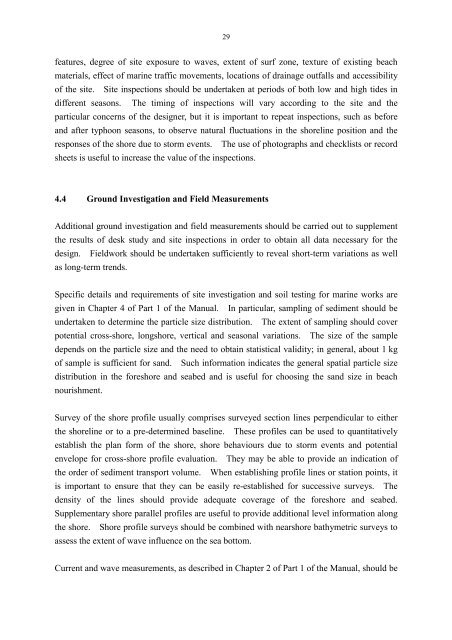PORT WORKS DESIGN MANUAL PART 5 Guide to Design of ...
PORT WORKS DESIGN MANUAL PART 5 Guide to Design of ...
PORT WORKS DESIGN MANUAL PART 5 Guide to Design of ...
Create successful ePaper yourself
Turn your PDF publications into a flip-book with our unique Google optimized e-Paper software.
29<br />
features, degree <strong>of</strong> site exposure <strong>to</strong> waves, extent <strong>of</strong> surf zone, texture <strong>of</strong> existing beach<br />
materials, effect <strong>of</strong> marine traffic movements, locations <strong>of</strong> drainage outfalls and accessibility<br />
<strong>of</strong> the site. Site inspections should be undertaken at periods <strong>of</strong> both low and high tides in<br />
different seasons. The timing <strong>of</strong> inspections will vary according <strong>to</strong> the site and the<br />
particular concerns <strong>of</strong> the designer, but it is important <strong>to</strong> repeat inspections, such as before<br />
and after typhoon seasons, <strong>to</strong> observe natural fluctuations in the shoreline position and the<br />
responses <strong>of</strong> the shore due <strong>to</strong> s<strong>to</strong>rm events. The use <strong>of</strong> pho<strong>to</strong>graphs and checklists or record<br />
sheets is useful <strong>to</strong> increase the value <strong>of</strong> the inspections.<br />
4.4 Ground Investigation and Field Measurements<br />
Additional ground investigation and field measurements should be carried out <strong>to</strong> supplement<br />
the results <strong>of</strong> desk study and site inspections in order <strong>to</strong> obtain all data necessary for the<br />
design. Fieldwork should be undertaken sufficiently <strong>to</strong> reveal short-term variations as well<br />
as long-term trends.<br />
Specific details and requirements <strong>of</strong> site investigation and soil testing for marine works are<br />
given in Chapter 4 <strong>of</strong> Part 1 <strong>of</strong> the Manual. In particular, sampling <strong>of</strong> sediment should be<br />
undertaken <strong>to</strong> determine the particle size distribution. The extent <strong>of</strong> sampling should cover<br />
potential cross-shore, longshore, vertical and seasonal variations. The size <strong>of</strong> the sample<br />
depends on the particle size and the need <strong>to</strong> obtain statistical validity; in general, about 1 kg<br />
<strong>of</strong> sample is sufficient for sand. Such information indicates the general spatial particle size<br />
distribution in the foreshore and seabed and is useful for choosing the sand size in beach<br />
nourishment.<br />
Survey <strong>of</strong> the shore pr<strong>of</strong>ile usually comprises surveyed section lines perpendicular <strong>to</strong> either<br />
the shoreline or <strong>to</strong> a pre-determined baseline. These pr<strong>of</strong>iles can be used <strong>to</strong> quantitatively<br />
establish the plan form <strong>of</strong> the shore, shore behaviours due <strong>to</strong> s<strong>to</strong>rm events and potential<br />
envelope for cross-shore pr<strong>of</strong>ile evaluation. They may be able <strong>to</strong> provide an indication <strong>of</strong><br />
the order <strong>of</strong> sediment transport volume. When establishing pr<strong>of</strong>ile lines or station points, it<br />
is important <strong>to</strong> ensure that they can be easily re-established for successive surveys. The<br />
density <strong>of</strong> the lines should provide adequate coverage <strong>of</strong> the foreshore and seabed.<br />
Supplementary shore parallel pr<strong>of</strong>iles are useful <strong>to</strong> provide additional level information along<br />
the shore. Shore pr<strong>of</strong>ile surveys should be combined with nearshore bathymetric surveys <strong>to</strong><br />
assess the extent <strong>of</strong> wave influence on the sea bot<strong>to</strong>m.<br />
Current and wave measurements, as described in Chapter 2 <strong>of</strong> Part 1 <strong>of</strong> the Manual, should be

















